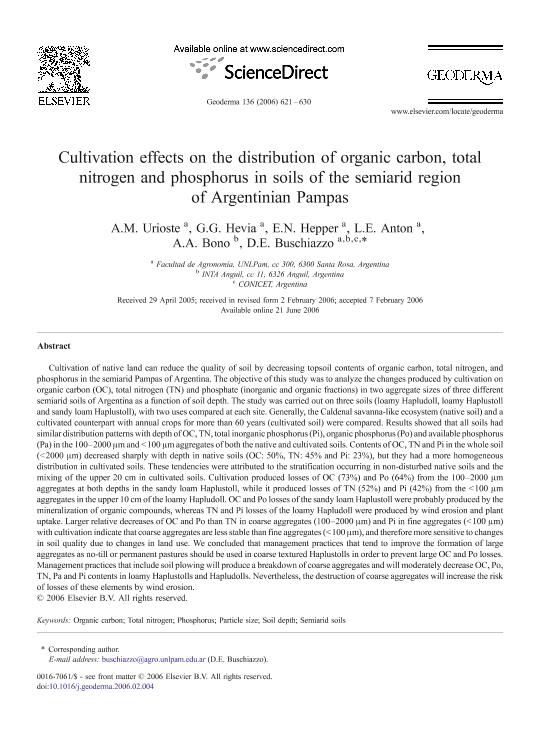Artículo
Cultivation effects on the distribution of organic carbon, total nitrogen and phosphorus in soils of the semiarid region of Argentinian Pampas
Ana María, Urioste; Hevia, Graciela Gloria; Hepper, Estela Noemí; Anton, L. E.; Bono, A. A.; Buschiazzo, Daniel Eduardo

Fecha de publicación:
12/2006
Editorial:
Elsevier Science
Revista:
Geoderma
ISSN:
0016-7061
Idioma:
Inglés
Tipo de recurso:
Artículo publicado
Clasificación temática:
Resumen
Cultivation of native land can reduce the quality of soil by decreasing topsoil contents of organic carbon, total nitrogen, and phosphorus in the semiarid Pampas of Argentina. The objective of this study was to analyze the changes produced by cultivation on organic carbon (OC), total nitrogen (TN) and phosphate (inorganic and organic fractions) in two aggregate sizes of three different semiarid soils of Argentina as a function of soil depth. The study was carried out on three soils (loamy Hapludoll, loamy Haplustoll and sandy loam Haplustoll), with two uses compared at each site. Generally, the Caldenal savanna-like ecosystem (native soil) and a cultivated counterpart with annual crops for more than 60 years (cultivated soil) were compared. Results showed that all soils had similar distribution patterns with depth of OC, TN, total inorganic phosphorus (Pi), organic phosphorus (Po) and available phosphorus (Pa) in the 100-2000 μm and < 100 μm aggregates of both the native and cultivated soils. Contents of OC, TN and Pi in the whole soil (< 2000 μm) decreased sharply with depth in native soils (OC: 50%, TN: 45% and Pi: 23%), but they had a more homogeneous distribution in cultivated soils. These tendencies were attributed to the stratification occurring in non-disturbed native soils and the mixing of the upper 20 cm in cultivated soils. Cultivation produced losses of OC (73%) and Po (64%) from the 100-2000 μm aggregates at both depths in the sandy loam Haplustoll, while it produced losses of TN (52%) and Pi (42%) from the < 100 μm aggregates in the upper 10 cm of the loamy Hapludoll. OC and Po losses of the sandy loam Haplustoll were probably produced by the mineralization of organic compounds, whereas TN and Pi losses of the loamy Hapludoll were produced by wind erosion and plant uptake. Larger relative decreases of OC and Po than TN in coarse aggregates (100-2000 μm) and Pi in fine aggregates (< 100 μm) with cultivation indicate that coarse aggregates are less stable than fine aggregates (< 100 μm), and therefore more sensitive to changes in soil quality due to changes in land use. We concluded that management practices that tend to improve the formation of large aggregates as no-till or permanent pastures should be used in coarse textured Haplustolls in order to prevent large OC and Po losses. Management practices that include soil plowing will produce a breakdown of coarse aggregates and will moderately decrease OC, Po, TN, Pa and Pi contents in loamy Haplustolls and Hapludolls. Nevertheless, the destruction of coarse aggregates will increase the risk of losses of these elements by wind erosion.
Archivos asociados
Licencia
Identificadores
Colecciones
Articulos(INCITAP)
Articulos de INST.D/CS D/L/TIERRA Y AMBIENTALES D/L/PAMPA
Articulos de INST.D/CS D/L/TIERRA Y AMBIENTALES D/L/PAMPA
Citación
Ana María, Urioste; Hevia, Graciela Gloria; Hepper, Estela Noemí; Anton, L. E.; Bono, A. A.; et al.; Cultivation effects on the distribution of organic carbon, total nitrogen and phosphorus in soils of the semiarid region of Argentinian Pampas; Elsevier Science; Geoderma; 136; 3-4; 12-2006; 621-630
Compartir
Altmétricas



